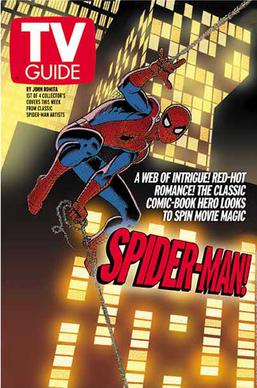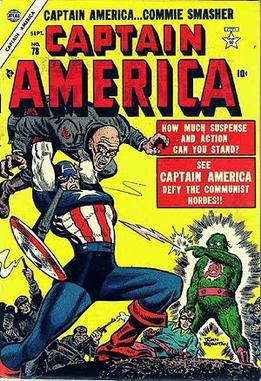John Romita Sr. facts for kids
Quick facts for kids John Romita Sr. |
|
|---|---|

Romita in 2006
|
|
| Born | January 24, 1930 Brooklyn, New York, U.S. |
| Died | June 12, 2023 (aged 93) |
| Area(s) | Penciller, Inker |
| Pseudonym(s) | John Romita |
|
Notable works
|
The Amazing Spider-Man, The Punisher |
| Awards | Inkpot Award 1979 Will Eisner Award Hall of Fame 2002 Inkwell Awards Joe Sinnott Hall of Fame 2020 |
| Spouse(s) |
Virginia Bruno
(m. 1952) |
| Children | 2, including John Romita Jr. |
John Victor Romita Sr. (January 24, 1930 – June 12, 2023) was an American comic book artist. He is famous for his work on Marvel Comics' The Amazing Spider-Man. He also helped create popular characters like Mary Jane Watson, the Punisher, and Wolverine. John Romita Sr. was the father of John Romita Jr., who is also a well-known comic book artist.
Romita started working in comics in 1949 for Timely Comics, which later became Marvel. There, he met editor-in-chief Stan Lee. In the 1950s, he drew many types of comics, including a new version of Captain America. From 1958 to 1965, he worked mostly for DC Comics, drawing many romance comics. This helped him become known for drawing beautiful women.
In 1965, Romita joined Marvel. He first drew Daredevil comics. In 1966, Spider-Man artist Steve Ditko left Marvel. Stan Lee chose Romita to draw The Amazing Spider-Man. Romita's art style helped The Amazing Spider-Man become Marvel's top-selling comic. In 1973, Romita became Marvel's art director. He had a big impact on how Marvel comics looked in the 1970s and 1980s.
He was honored in the Will Eisner Comic Book Hall of Fame in 2002.
Contents
Becoming a Comic Artist
Early Life and Art Training
John Romita Sr. was born and grew up in Brooklyn, New York City. His father, Victor Romita, was a baker. John graduated from the Manhattan's School of Industrial Art in 1947. He learned from great illustrators and was inspired by famous comic artists like Milton Caniff. Caniff's Terry and the Pirates comic strip was a big influence on him.
When he was 17, Romita got his first art job. He created a medical exhibit for a hospital. In 1949, he started working in the comics industry. A friend from high school, Lester Zakarin, offered him a job drawing comics. Romita drew stories for Timely Comics, which was the company that later became Marvel. This helped him meet Stan Lee.
Working for Atlas Comics
In 1951, Romita joined the United States Army. He was stationed in New York and drew recruitment posters. When he wasn't on duty, he visited Stan Lee at Atlas Comics. Atlas was the new name for Timely Comics. Romita started drawing many different types of comics for Atlas. He drew horror, war, and romance stories.
One of his most important jobs at Atlas was drawing Captain America. He drew Captain America in Young Men and Captain America comics in 1953 and 1954. Romita also created one of his first original characters, M-11 the Human Robot. He also drew "Waku, Prince of the Bantu," one of the first comic series with a black main character.
Drawing Romance Comics for DC
In the mid-1950s, Romita started doing some work for DC Comics. By 1958, he was working only for DC. He became known for drawing romance comics like Secret Hearts and Heart Throbs. He often drew the covers for these romance comics.
Romita learned to draw beautiful women during this time. He used pictures from movies and other comic strips as inspiration. He hoped to draw superhero comics for DC, like Batman. But he mostly stayed with romance comics. By 1965, romance comics were not as popular, and DC stopped buying new art for them.
Joining Marvel Comics
Return to Marvel
Even before he stopped working for DC, Romita began freelancing for Marvel Comics again. His first work for Marvel was inking a cover for The Avengers in 1965.
Stan Lee heard that Romita was leaving DC. He met with Romita and offered him a job at Marvel. Lee promised to pay him well and let him work from home sometimes. Romita wanted to be an inker, but Lee convinced him to draw again. Lee showed him a Daredevil story and asked him to draw Daredevil in his own style. Romita's drawing impressed Lee.
Romita started drawing Daredevil comics in 1966. He learned Marvel's art style by drawing over Jack Kirby's layouts. Sales for Daredevil went up. This work was a step towards his famous run on The Amazing Spider-Man.
The Amazing Spider-Man

Spider-Man co-creator Steve Ditko left Marvel in 1966. Stan Lee then asked Romita to draw The Amazing Spider-Man. Romita took over the comic with issue #39 in August 1966. At first, he tried to draw like Ditko, but soon he developed his own style. Romita's style became the new look for Spider-Man.
The Amazing Spider-Man was Marvel's second best-selling comic when Romita started. Within a year, it became the company's top seller. Romita designed the look of Mary Jane Watson, who became a very important character in Spider-Man's life. He based her look on actress Ann-Margret.
Other characters that first appeared during Romita's time on Spider-Man include:
- The Rhino
- The Shocker
- The Kingpin
- George Stacy
Romita's stories with Stan Lee focused on Spider-Man's adventures, but also on the characters' social and college lives. They even touched on real-world issues like the Vietnam War.
Romita often helped other artists and worked closely with Stan Lee. He started doing only layouts for Spider-Man, with other artists finishing the pencils. Romita also suggested that Gwen Stacy should die in issue #121. This event, known as "The Night Gwen Stacy Died," was a very important moment in Spider-Man's history.
Romita's work on Spider-Man changed the character's look. It made Spider-Man popular with even more readers. He also drew the Spider-Man newspaper comic strip from 1977 to 1980.
Becoming Marvel's Art Director
In 1972, Stan Lee became Marvel's publisher and president. In July 1973, he officially made Romita the art director. In this role, Romita helped shape the look of many Marvel Comics. He also helped design many new characters, including:
- The Punisher
- Wolverine
- Luke Cage
- Bullseye
- Tigra
- Brother Voodoo
For Wolverine, Romita based the design on how wolverines were described: small, fierce animals with claws. For the Punisher, he made the skull on his chest much bigger. Romita also designed Natasha Romanova's Black Widow outfit.
Romita also worked on special projects. He supervised other artists, made corrections, and drew art for merchandise. He inked Jack Kirby's work on Captain America's Bicentennial Battles in 1976.
Later Career and Legacy
Romita continued to contribute to Marvel comics for many years. He inked the first appearance of Captain Marvel in 1982. He also inked the first appearance of the Hobgoblin in 1983. He drew stories for Peter Parker, the Spectacular Spider-Man and The Amazing Spider-Man in the 1980s and 1990s.
In 1999, he drew "The Kiss," a flashback story where Peter Parker and Gwen Stacy share their first kiss. He also drew for milestone issues like The Amazing Spider-Man #500. Romita drew one of the covers for TV Guide in 2002, featuring Spider-Man.
He also contributed to special anniversary issues for other heroes he had drawn, like Captain America and Daredevil. In 2007, a U.S. Postal Service stamp set featured a Spider-Man image drawn by Romita.
Romita was part of The Hero Initiative, a charity that helps comic book creators in need. His son, John Romita Jr., also became a famous comic artist.
Awards and Recognition
John Romita Sr. received several important awards for his work:
- He won an Inkpot Award in 1979.
- He was inducted into the Will Eisner Award Hall of Fame in 2002.
- He was inducted into the Inkwell Awards Joe Sinnott Hall of Fame in 2020.
Personal Life
John Romita Sr. married his childhood sweetheart, Virginia Bruno, in 1952. Virginia also worked at Marvel Comics for many years. They lived in Brooklyn before moving to Queens Village and then Bellerose, New York, on Long Island.
They had two sons, Victor and John Jr.. John Jr. followed in his father's footsteps and became a well-known comic book artist.
John Romita Sr. passed away on June 12, 2023, at the age of 93.
See also
In Spanish: John Romita Sr. para niños


